#Timeline Plugin
Explore tagged Tumblr posts
Text
In the dynamic world of web design, unlocking the magic of Gutenberg Timeline Blocks within WordPress unveils a realm of possibilities that far surpasses other timeline solutions. The seamless integration of Gutenberg with WordPress Timeline Blocks offers a user-friendly and intuitive experience, allowing even novices to effortlessly craft captivating timelines for their websites.
#Gutenberg Timeline Blocks#Timeline Plugin Wordpress#Cool Timeline#Gutenberg Wordpress#Timeline Plugin#Wp Timeline#Page Timeline#Custom Gutenberg Blocks#Wordpress Timeline Plugin Free#Wp Timeline Plugin#Gutenberg Blocks#Horizontal Timeline Plugin Wordpress#Wordpress Blocks#Timeline Plugin Wordpress Free#Cool Timeline Plugin
0 notes
Text
Our shitty graphic designer is always touting square space as the best and only web platform and insisting on how we should force all our clients to switch to squarespace because he literally doesn’t know how to use (& refuses to learn) any other platforms and he KEEPS trying to push it and mostly gets his way because he’s a pushy asshole white man and because no one else at the firm has web dev experience but I have more experience than him and I stg I am going to beat this man into the ground
#he was trying to bring it up again on a client call and I finally was like#yep so wix has this plugin and these capabilities which make it perfect for this ask (since the client is already using it)#so it sounds like we’ll just want to think through streamlining integration later in the contract#when we’re not under a super tight timeline :)#……and now he wants to have a call about their website#motherFUCKER#personal#edit: this is not a pro-wix post this is a 'stop being a jackass' post
6 notes
·
View notes
Text
Introducing the JNext Timeline Plugin for WordPress - the ultimate solution to showcase your content in a visually captivating and interactive timeline format. Developed by the experts at JNext Services Pvt. Ltd., this plugin is designed to seamlessly integrate with your WordPress website, allowing you to create stunning timelines with ease. Whether you want to highlight your company's history, showcase project milestones, or display a chronological series of events, our Timeline Plugin has got you covered.
#Timeline Plugin for WordPress#WordPress Timeline Solutions#JNext Timeline Plugin for WordPress#WordPress Timeline Plugin#JNext Services#JNext Technologies
0 notes
Note
hi sole! your sharpening is always so soft and pretty, i was wondering if you would be open to share it? hope you are having a wonderful november so far <3
Hi, Anon! Thank you so much <3 Yeah, sure, tutorial under the cut:
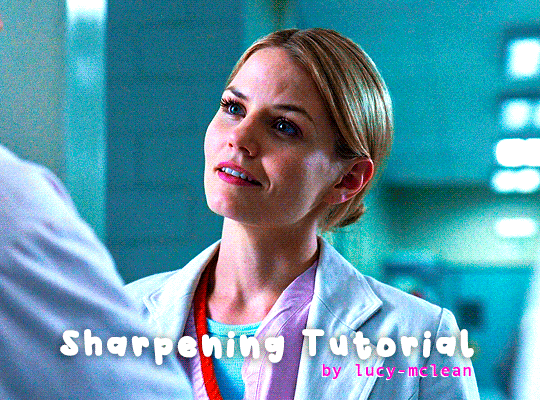
What you'll need:
Photoshop (I use Photoshop 2023)
Basic knowledge on how to make gifs
Camera Raw filter installed
Okay so, first of all, I use two different methods depending on the size of the gif. Let's start with the one I use for most of my gifsets which are big gifs (examples: x x x x.)
METHOD #1: Smart Sharpen + Camera Raw
I started using the Camera Raw filter last year and let me tell you, I'm obsessed! It completely changes the game of sharpening. I use this method for all gifs with a 540px width.
We're going to work on timeline so get your gif ready and convert it for smart filters. I'm using this scene from my last set as a base:

Here's the gif after I color it (I usually sharpen my gifs before I color them but for the sake of the tutorial I'm showing you this so you guys can see the difference):

(1) Smart Sharpen Layer: Let's start by adding a Smart Sharpen layer (Filter > Sharpen > Smart Sharpen) with these settings:
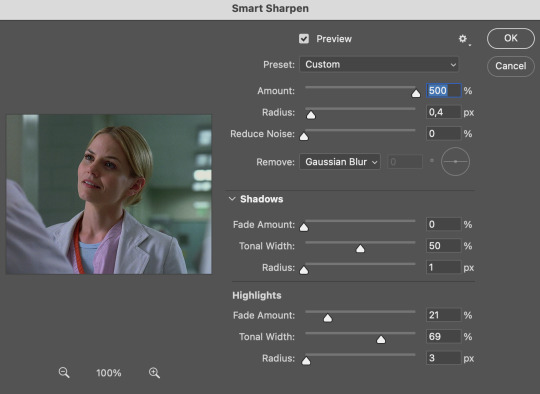
Disclaimer: I didn't come up with these settings myself I got them from these sharpening actions forever ago so I don't know which one it is :/. I also wasn't able to find that person's new blog (if they even have one since they've been inactive since 2021) so if anyone knows please let me know and I'll give them proper credit!
Now we're going to go to the 'Layers' panel and click on this little thingy:

This window will pop up and we are going to change the Opacity to 50%.
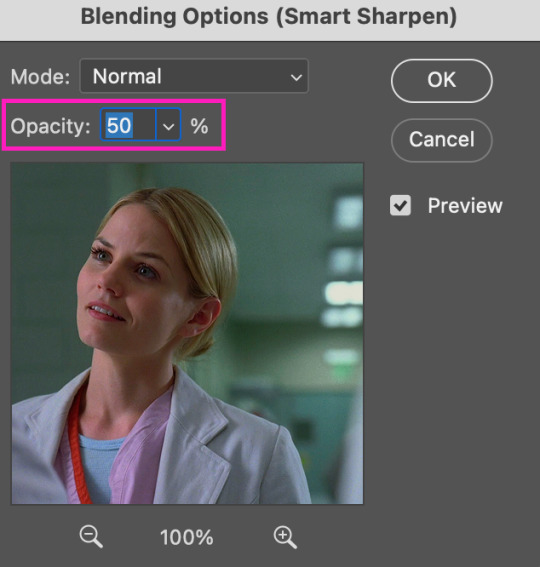
(2) Camera Raw Filter: Here's where the fun begins. Go to Filter and click on Camera Raw Filter (you'll need to have the plugin installed for it to show up.) I don't know how the Camera Raw window will look like the first time you open it but good thing you only need to change a couple of things!
If it isn't opened yet click on 'Effects' and we're going to change the Texture and Clarity:
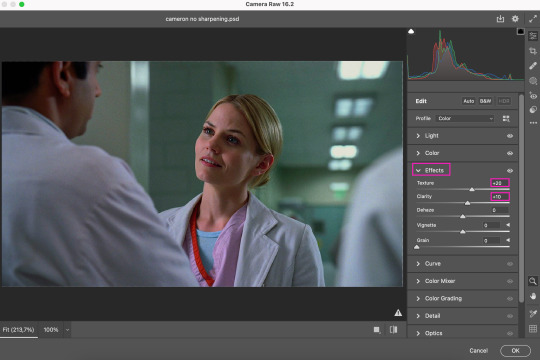
Depending on the scene/show/film I'm giffing, or if I want a stronger or softer sharpening, I'll use two different settings, but 99% of the time they are these:
First setting: Texture (+20) Clarity (+10)
Second setting: Texture (+40) Clarity (+20)


As you can see the difference isn't huge but the first setting gives a "softer" look. As I said I'll use one or the other depending on how I see the scene (it's almost always about the vibes yk.)
Feel free to experiment with these two and see what works best for you (although I wouldn't go higher than 40 on texture because the sharpening will look too fake imo.)
Also this filter is soooo good at making low quality videos look 1080p! Every time I've had to use 720p videos the Camera Raw filter has saved me 🫡
METHOD #2: Smart Sharpen
I use this method for smaller gifs. For example, 8 gifs of 268px x 180px sets (like these) or small-ish gifs in complex sets (like the second gifs in this set.)
This process is much simpler since it's the one I explained before but without adding the Camera Raw filter. That's it that's the method. Just a Smart Sharpen layer with the Opacity turned down to 50%.

As I said this method looks best on smaller gifs but to be honest it looks good on big gifs too? Depends on what you like most!
Anyway I hope this was easy to follow and if anyone has any questions please feel free to dm me or send an ask! ♡
#ask#Anon#ps tag#useraljoscha#usermelone#userchibi#usermagic#uservivaldi#userlorna#tuserhol#usercats#userlix#usersavana
244 notes
·
View notes
Note
Im interested by what you said about using Obsidian for writing. I downloaded it and was messing around with it a bit and it seems really interesting and very much like what I'm looking for but certainly like it could be... a lot too lol
Do you have any recommendations for someone wanting to start using it for writing?
step one is to get the longform plugin, that's what lets you use obsidian a little more like scrivener, where every project has its own folder full of markdown files that you can sort freely (these days i'm still in the habit of just naming chapters numbers, but if you actually want chapter titles or something that looks nicer than numbers this is crucial). so in my case I have a folder called Writing, a subfolder of that called Fanfic, and a subfolder of that called Sorrowverse. i right-clicked on the Sorrowverse folder and said "create new longform project", named it Wayne Manor, and then it created the folder with an index. then i moved all my existing markdown files into that folder, and when i opened the Wayne Manor project in longform it asked if i wanted to import those files as scenes (i did).
if you want it to be even more like scrivener you can give each chapter its own folder and then every scene in that chapter its own file. i might go back to this someday but for a long time i was using typora so i've got different habits.
i have not yet found a good way to make backlinks useful in my fiction but i'm sure there's a way. like, it would be neat to be able to see all of sorrowverse on a timeline, or see which fics lowkey reference each other, but if there's an unobtrusive way to do that i haven't figured it out yet. i set a daily goal in longform of 400 words and have it set to apply to all projects but it's still a little iffy if it wants to work right, especially when i'm syncing files via third party cloud storage. being able to start a new writing session helps with this one.
the only files i keep visible in longform are the ones i want to be included if/when i eventually compile the whole project, brainstorming or snippets are in the same folder in fileview but they don't appear in longform. this might be a good use of backlinks actually but i haven't needed to bother with that yet, my files are pretty easy to navigate manually still.
anyway. i actually found it more helpful to use for writing after i started also using it for journaling, since having a daily note to think out loud in means i can open the app up without any pressure to do anything but word vomit, and then as long as i'm in there i can putter around in my other files and things. i also installed the Tasks plugin and created a todo list, a special note that does nothing but tell me everything i want to get done that date, and a template for my daily note that includes all the tasks i completed that day so i can go back and see everything i did.
to start with you can always just write in it the same way you'd write in word, if you're not used to markdown i think there's plugins to give it more of a wysiwyg feel but personally i prefer my little asterisks and whatnots.
116 notes
·
View notes
Note
Hey, I love this story so far!
As someone who is considering writing their own Interactive Fiction, I'm curious what your process for writing a chapter is. Like you mentioned zero drafting a while back, and I found it's really helped, so are there any other techniques you'd recommend? :0
Omg hiiii! It’s definitely a labor of love, but it’s so rewarding. I wish you luck if you end up going for it!
I'm a feeling a little uhh shy doing this since I'm not the fastest nor greatest writer out there... but I’d be happy to share what’s worked for me so far.
Just know that everyone's process is unique, but I hope something here clicks for some of you :D
Tips?
Try to avoid jumping around scenes/routes
I used to jump around from scene to scene, but I’ve found that it makes me prone to flow and continuity mistakes. It's especially troublesome as the story gets bigger.
Now I try to focus on one route or scene at a time. This helps me stay in right headspace, keeps everything cohesive, and is much more efficient.
If you find yourself tempted to jump around, try sticking with one part until it’s complete, or at least until you’ve written a solid chunk of it!
Use CSIDE's (find | find & replace) function to help look for pronouns/names. And do a quick test before playtesting your game
Not sure if everyone uses this... but Ctrl + F then typing the word (ex. he/she/her/him etc) you want to change into a variable helps so much. Especially for hunting pronouns. Highlights words making them easier to see.
A quick Ctrl + T will save you from pain when you're deep into playtesting...
Try the CGST plugin for playtesting routes
I mainly use it for the back button and seeing notifications when a variable changes. With this you can quickly check if all choices are working as intended. It's super useful!
Only caveat is that it only works in Firefox.
Oh and yes, you'll have to upload a private demo for playtesting in COGDemos to try it out ( ˙▿˙ )
Zero Drafting
I know I mentioned it already, but I have to rave about it again!
If you're struggling with where to start, this method might help you. It’s all about getting your ideas down first. It's okay if it’s a mess. Just pour everything into your draft. The main goal here is to keep your ideas flowing, you can always refine them later.
This gives you a foundation to work from and, in my experience, it's a huge relief knowing you don’t have to perfect everything immediately.
You can also mix in coding during the zero draft phase! It’s a great way to test how the choices fit together with the scene you’re working on.
Laying out all the groundwork can save a lot of time in the long run.
Apps that helped me (and might help you too!)
Articy (free)
Not only can it help visualize the paths, but it can track variables too! Also has tabs where you can store character and other lore entries. It has its own language so you'll have to learn it for awhile, but it's pretty easy to understand if you have time :)
I don't use it anymore though since I feel more comfortable doing everything in CSIDE now. But it still helped me a lot when I was getting dizzy with all the gotos, labels, and stuff.
Notion (free)
Just a neat place to store outlines, lore, or ideas! I used to use simple google docs, but this one has more features like; create checklists, put existing pages (scenes) into a timeline, etc. In case you're curious, I used this template in particular.
30 notes
·
View notes
Text
I think i have things-changing idea about improving video watching experience for people with photosensitivity conditions (epilepsy, migraine, etc)
so, my friend showed me an app/plugin (idk), which can recognize sponsorship parts of videos and auto-skipping it
it looks like that in youtube design

so this thing shows you the part which it can skip (red one on the picture) and well, skip it
and i thought like
we can do this for flashing lights, right?
if some dudes made algorithm, which can recognize something so complicated, i think it's definitely possible to make algorithm which simply counts frequency, intensity, area, patterns* (i mean, it's 2+2 for computer, right?), then compare it to not-harmfull diapason, and if numbers are out of it - then algorithm could make that thing on the picture above - mark it on video timeline and make an option to skip it. i would also add some addition which could show numbers and if person can handle this level of intensity - this person can choose not to skip it.
i know nothing about computers, IT and coding so, just giving idea to the world. if someone already making/made something like this - pls, tell about the project in reblogs, i will use my blog as a platform to share. if it is a thing already - great, will share too, because it should be more popular then
*i learned these terms reading article on https://www.epilepsy.com
256 notes
·
View notes
Text
@noyoucantpinmedown since you asked...
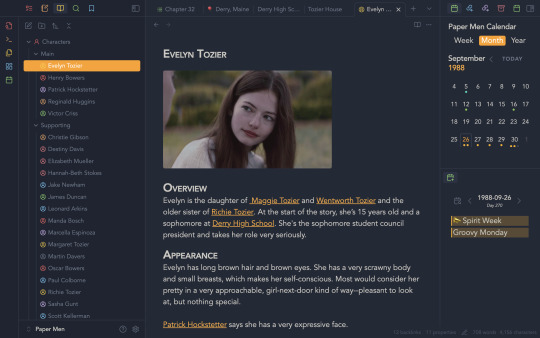
The app is Obsidian, which you may have heard about already. I believe it’s a fairly well-known markdown writing application. I’ve known about it for years myself, but I was really intimidated to use it because… well, it’s got a pretty steep learning curve and takes some effort to get it set up just right.
Once you get it, though, it’s amazing! It’s simple but powerful, and there are tons of community plugins available, which add an endless amount of customization options. I like the Calendarium plugin myself because I love making story-specific calendars. Paper Men especially benefits from one.
Best of all, it's completely free for personal use, which I love because I'm trying to get away from all those annoying subscription-based apps. I’ve deleted all of them except for Aeon Timeline, which technically is a buy-once-and-own-forever model, but you need to subscribe for updates. That app is my favorite app in the world, but it’s not best for text-heavy notes because the formatting options are so limited.
Anyway, I can’t share a ton of screenshots because it’s messy as hell and full of spoilers. But I basically took all my notes off Aeon Timeline (which again, not the greatest for text) and moved it here. All your notes are kept in “vaults,” so I have vaults for Paper Men, Dancing with Myself, and the novel version of DWM that I’m slowly picking away at…
Sorry for info-dumping. I bet you regret asking me which app I was referring to now, don’t you? 😂
#don't ask me a question unless you're prepared for me to ramble#I love a good ramble#fic writing#writing software#paper men#ambrossart
30 notes
·
View notes
Text
A Brief Lifelog | Are We So Back? | RIP MARL(for now)
I don't intend to do a lot of these real life things. I'm not the most public person, but I did want to give a little update since I've been developing again and maybe I'll even be updating this blog a bit more frequently.
So why do I keep ghosting y'all?
The long and short of it, about a month ago I got diagnosed with ADD, finally and to no one's surprise, and started Vivance to help. I dare say that it has helped quite a lot. The last month has been much better for focus, mood, and productivity and I've actually been applying that to game development more. It's felt really good to be making things more earnestly than I've been able to before.
Have I been working on MARL?
No. I was making MARL in Easy FPS Editor, but the dev has announced that there is no more serious work being done on EFPSE, instead they're working on a more robust engine in a similar vein. I'll likely return to MARL at some point once Easy Game Builder is out and a bit more polished, but for now, MARL is on hiatus.
If not MARL then what?
My attention over the past month or two has been twofold, but I've been trying to keep myself focused on Godot for the time being. To celebrate getting on my new meds I made a game for the Neurodiversity Pride Canada Jam about ADD and old timey prospectors. A friend of mine did some voice work for that game and while I should have put some of the voice lines on a cooldown, I'm still really happy with Denrite Trail. It's unironically the best jam game I've ever made and I've really proud of the work I did, even if I'm not much of a programmer.
More currently though, I have two things in the pipes. One has been a hobby project I've started to hone in my spritework a bit more. It's a fairly lighthearted and lightweight point and click game using a plugin called Popochiu. It's mostly for practise, to familiarize myself with Popochiu, and to get some more practice in for a future supernatural mystery game that I've been wanting to make for a while. I really like point and clicks(I've been playing and loving Sam and Max Save the World recently) and I'm pretty excited to make some. The future mystery game, not this little goof, may also be my first commercial project, or at least my first personal commercial project.

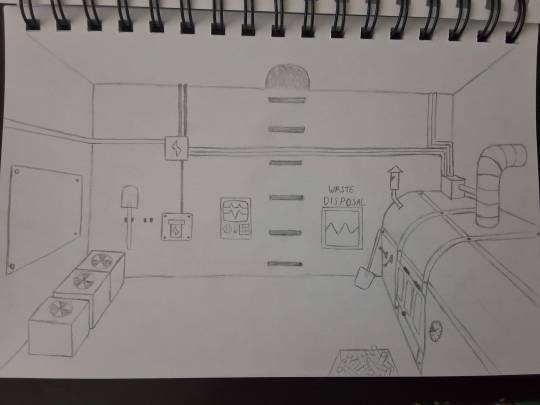
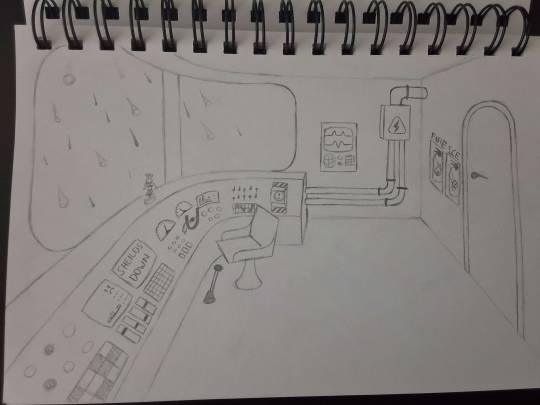
The second game I've been working on I've been working on with a couple of friends is a bit more ambitious, but also not strictly my project. I've been doing visual design and modelling for a scifi multiplayer FPS that my friend is heading. I'm not sure exactly how much I should talk about it given the still fairly early stage of development, but I'm still really happy with the work I've been doing there. This project is intended to be a commercial project and it's got a more specific timeline than my hobby project. If all goes well, I may be posting about it's release in a few months.



Regardless of which one comes out first or comes out at all, I have not been as idle and distracted as I used to be. It feels good to have some creative energy back and it feels better to be able to sit and focus more regularly. I'm expecting that I'll be more active here at least for updates, but I'm still figuring out what kind of devlog works best for my new, medicated, work schedule. I honestly don't know if I'll be returning to Youtube. I did like making videos, but they're a time consuming process that takes a lot of time and energy off of my actual development. However, I have been meaning to get back to streaming again. I don't know when exactly, but likely I'll reassess my schedule, energy and ability to stream once I've wrapped up the group FPS project I'm working on since that is taking most of my work hours these days.
Whenever I'm back, and whether I'm back at all in the public sense, this is a new era for me. New meds are working, my brain is working, and the game juice is flowing.
#game development#indie dev#devlog#marl devlog#IDK what else to tag so instead just go watch Miss Sherlock
7 notes
·
View notes
Note
i like your songs! the sense of style & originality in the composition is something i love in voca songs. i was wondering if u have any kind of production tips you'd be okay with sharing. personally i get stuck on mixing/mastering a lot, but i'm curious what your work flow's like!
So as for production tips, I think that it really comes down to the type of music you're making, and your own personal preferences for sound. For context here, I mix using Cakewalk and it's default plugins, since I don't have FL Studio.
I always start with compression when mixing, so that the volume is already normalized when I begin editing everything else. I usually use a regular compressor and lower it to about -12 or until the volume at the loudest parts is no longer clipping or peaking, but for more tinny sounding vocals, I'll use a multi-band compressor to lower the high parts specifically without muddying the rest of the channels. After that I move onto adjusting the EQ and reverb; I personally prefer more crisp, dry sounding vocals, so when doing EQ and reverb, I adjust the high end until the vocals sound clear but not loud, and lower the rightmost part if the vocals get too loud.
For reverb, I lower the timing/tail of the reverb as low as it will go so that the vocals don't sound super echoey, or like they're coming through a tube. Then I'll adjust the size and width of the vocals until they mix well with the music without sounding echoey. However, if a song I'm doing requires a more echoey or wide sound, I'll turn the reverb up just enough to get it to echo, then after that I'll adjust the tail until I get the desired effect. I rarely use delay, but when I do, I always use it sparingly, because it can easily overwhelm the instruments and bleed into parts I don't want.
A big thing to remember is that automation is your best friend. I used to just cut up tracks and have different effects for those tracks, but then I learned how to use automation. If you need more reverb or less crisp vocals in a certain spot, take advantage of the automation tracks to adjust the levels along the timeline. One big thing to look out for when automating reverb and delay, is that even after lowering the levels of what you want, the effect will still be applied to the part for a few measures afterward, and will take a second to wear off your vocals. I found this out when making Keshi Ga Saku Tokoro, as the reverb from the chorus kept bleeding into the second verse and making it sound too hollow; I fixed it by moving the automation points for all my reverb and delay back by about two to three measures. I have no clue why it works this way, but it just does.
I have no clue how to master, I just throw gain, EQ, a multiband compressor, and whole bunch of other junk onto the master track and play with it until it sounds loud and even. Occasionally, since I make my instrumentals in Bandlab, I'll just throw my unmastered track in and "cheat" by using the auto-mastering feature, although that tends to be a bit iffy if I'm looking for a certain effect for my music, as it may dampen certain parts that I want to be loud.
That's really all I have in the way of tips, but if you want to know my workflow, I start by making a beat to work off of, and adding a bassline to that. Then I'll take a piano or pad and try to find some notes that sound good next to each other, and by good I mean they sound like I want them to, not consonant. Sometimes I want a more dissonant sound that doesn't resolve. Then I'll turn those notes into chords and play with the timing and rhythm until I get something good, then I'll add a few more layers with different instruments that have the same or similar patterns.
For bass instruments, I'll remove the chord and only use the base notes, lowering them a couple of octaves. For middle instruments, I'll copy the chords, and then paste them in at a lower octave to make them feel fuller, and for higher instruments, I'll simply move the chords higher. After that I spend several days crying about how I'm unable to achieve the exact sound and pattern that I have stuck in my head, before I give up and make something else entirely that sounds absolutely nothing like I had in mind, because I don't actually know what I'm doing.
Next, I'll move my unmastered instrumental into my vocal editor of choice, usually VOCALOID, and agonize over what vocal pattern I should use. Once I get a nice vocal melody, I'll scrap half of it and redo them because I suddenly realize that they sound boring and weird, then I'll cry and give-up for about two days, or even a week before I come back to try again. Then I'll announce the song way too early before I'm finished with it, in hopes that it will give me the motivation to complete the song, only for me to immediately fall into a creative slump where I can't do anything and I feel exhausted. I then delete the announcement and come back a month later when I'm actually done by some miracle, and then try again, but this time with a finished product.
And that's really about it. I hope this was helpful!
8 notes
·
View notes
Text
I started writing "4 srs" this month and I like how free and accessible writing is, so I'm recommending free software I've experimented with that might help people who want to get into the hobby!
“Specifically Created for Writing Stories”
-------------------------------
Manuskript – Story organizer / word processor. Has an outliner and index card function, along with distraction free mode. Lets you switch between different templates such as a non-fiction mode or a short story.
Bibisco – Novel writing software that includes writing goals, world-building, distraction free mode, and a timeline.
“I Just Want to Write”
---------------------------
LibreOffice – Microsoft 365 alternative, but free! LibreOffice Writer is what I wrote this tumblr post in before I posted it. Also if you copy & paste the text into the Rich Text Editor on AO3, it seems that it actually converts it properly. Nice! No need for scripts.
Note-Taking
-------------------------------
Zim Wiki - note taking application that is very, very lightweight (1.1mb). It functions with a tree structure, so I’d personally recommend it for world-building and character bios. There are built-in plugins that also turn it into a good software for task management (it even has a article on how to use it for GTD) and journalling. See also: CherryTree (2mb), which is a more outdated-looking app, but functions similarly.
Obsidian MD – The Big Boy. markdown note editor that has been adopted by personal knowledge management fans---if it doesn’t do something you want it to do, just look in the community plugins to see if someone has already done it. Some unique non-word processing related usages I’ve found is the ability to create a table of contents dashboard, a image gallery for images, embedding youtube videos and timestamping notes, so forth.
Logseq – A bullet point based markdown note editor that also has PDF annotations, Zotero integration, flashcard creation, and whiteboards. Best used for outlining projects due to the bullet point structure.
Joplin – A modern app comparable to Zim Wiki, it’s basically just a note-taking software that uses folders and tags to sort easier. Looks prettier than Zim Wiki and Cherry Tree
Notion – An online-only website that allows usage of different database types. Free for personal use. Note: I dislike the AI updates that have been making the app lag more. I prefer the others on this list.
Mind Maps
-------------------------------
Freeplane – So much goddamn features, including a ton of add-ons. Looks somewhat ugly, but it works for anyone willing to spend a while learning how to use it.
Mermaid – Text-based diagram creator. Can be used in apps like Joplin, Notion, and Obsidian.
Obsidian’s Canvas – A core plugin for Obsidian, it deserves its own mention in that it allows you to create embedded notes of the mindmap nodes. Thus, if you want to create a 20-page long note and have it minimized to the size of a penny on the mindmap, you could.
Other Things That Might Be Of Interest
Syncthing - A free software that allows you to sync between two or more computers. Have a desktop but also laze around on a laptop in bed, coming up with ideas?? This is your buddy if you don't want to use a online software.
126 notes
·
View notes
Text
Are you looking for an engaging and visually appealing way to showcase a timeline on your WordPress website using Gutenberg? Look no further! Introducing WordPress Timeline Plugin, the ultimate Gutenberg Timeline Block Plugin that allows you to create stunning and interactive timelines with ease.
#Wordpress Timeline Plugin#Wordpress Curve Timeline Plugin#Timeline WP Plugin#Elementor Timeline Widget#Divi Timeline Plugin#Vertical Timeline Plugin Wordpress#Wordpress Plugin History Timeline#JNext Timeline Block#Gutenberg Timeline Plugin#History Timeline#Wp Timeline Plugin#Timeline Elementor#Wordpress Timeline#Wordpress Timeline Plugin Free#Horizontal Timeline Wordpress#Wordpress Timeline Template#Wordpress Horizontal Timeline#Gutenberg Timeline Block Plugin#Timeline Plugin#Curve Timeline Plugin#Timeline Block for Gutenberg#JNext Timeline Plugin#WordPress Timeline Block Plugin#elementorelementor#addonelementor#timelineelementor#widgetstimeline#eventshistoryHorizontal#Timelineroadmaptimeline#Gutenberg Timeline Plugin in WordPress
0 notes
Text
I want video player syncing to be a thing!
Like when I switch from using my desktop to using my laptop (or vice versa) I want to be able to see what video files are open on that other machine I was just using (in the way that Firefox let's me see what tabs I have open on other devices) and then (assuming that the video is in a shared folder and accessible over the local network) let me open it and jump to the same position on the timeline that the other machine is at.
There's no way to do that, right?
Other than to write my own very elaborate VLC plugin (which is I think a little beyond my ability or level of motivation)? Or to just stream the other machine's screen using Parsec?
34 notes
·
View notes
Text
A Visual Journey with Gutenberg Timeline Plugin

Enhance your website with the dynamic and visually engaging JNext Timeline Block Plugin. This powerful tool allows you to effortlessly showcase chronological events, milestones, and achievements in a sleek and customizable timeline format. Captivate your audience with interactive timelines that seamlessly integrate into your site, offering a compelling storytelling experience. Whether you're a blogger, business professional, or educator, the JNext Timeline Block Plugin is the perfect solution to bring your content to life. With user-friendly customization options and responsive design, create a captivating narrative that leaves a lasting impression on your visitors. Elevate your website's storytelling potential with the JNext Timeline Block Plugin – where past, present, and future seamlessly converge in a visually stunning display.
#Timeline Blocks#WordPress Timeline Block#WordPress Timeline Plugin#Timeline Block Plugin for Gutenberg#JNext Timeline Blocks#JNext Timeline Block Plugin#JNext Timeline Plugin#WordPress Timeline Block Plugin#Curve Timeline Plugin#Timeline Block Plugin#Gutenberg Timeline Plugin#Wordpress Curve Timeline Plugin#Timeline WP Plugin#Elementor Timeline Widget#Divi Timeline Plugin#Vertical Timeline Plugin Wordpress#Wordpress Plugin History Timeline#JNext Timeline Block#History Timeline
0 notes
Text
I am in the process of making a fairly comprehensive calendar of Tamriel for the Obsidian.md plugin Calendarium. Would anyone be interested in having a copy when I'm done?
Currently I'm only planning to include at most the Third and Fourth Eras, and I'm using UESP as my primary source with my own interpretations for specific dates. When travel time is applicable, I'm referencing @nuwanders' maps, because they're what I use for travel time in my fic and I am very much a stickler about that sort of thing.
It will include my own headcanons for certain things and changes to a few others, because I can, but if you want it, once you have it you're welcome to change things.
I might considering sharing the regular timeline as well, if people are interested, since I need to make one anyway to help with picking specific dates for things.
#m speaks#tes#skyrim#elder scrolls#oblivion#tes lore#tesblr#the elder scrolls#the second era is such a mess and it would be so much work to make things make sense esp with the non-chronological order of eso#hence why I'm only doing 3E and 4E unless I get seriously bonked with the Wabbajack and nobody stops me
18 notes
·
View notes
Note
I was wondering if you could explain how the Matrix actually... works? Is it more like a Time Lord artificial afterlife, or just a collection of knowledge? Do you ask your dead housekeeper for her cookie recipe, or do you just access it like Google?
Absolutely!
How does the Matrix work?
Think about Wikipedia.
Now, imagine if Wikipedia had detailed profile pages of every single member of the human race that had lived since its inception in 2001 (around 7.5~ billion individual, heavily detailed profiles).
Then, imagine each profile page had a little downloadable file that was that person's consciousness.
Next, think about how every person's knowledge gained in their life is spread throughout that Wikipedia on every single subject.
Now, think, 'What if Wikipedia had a plugin that could tell you future events based on all the information it has from all these people's experiences?'
Finally, put all this into a cool little weird video game that uses virtual reality.
If you can imagine that, you're pretty close.



💻 Functions of the Matrix
Knowledge Repository: The Matrix acts as an archive, containing the lived histories and profiles of every Time Lord that's lived, and all the knowledge they gained in their life.
Quick Updates: Living Time Lords are biologically connected to the Matrix, able to access the information at will (except if you've been a bad Time Lord, of course). When they die the Matrix automatically creates their profile page when they die, so their entire life goes to the Time Lord Wiki for the benefit of all.
Simulated Reality: If entered, the environment is a simulated reality where the personalities of deceased Time Lords can continue to exist. This can make it seem like a kind of artificial afterlife where you could potentially interact with past or future incarnations of Time Lords.
Predictive Tool: The Matrix generates prophecies and foresees potential futures, guiding Time Lords in making informed decisions about potential timelines.
Physical and Astral Projection: Time Lords can also use the Matrix to project their images across spacetime or within the confines of a TARDIS, communicating across vast distances or even between different temporal phases. Isn't that handy?
🔐 Security and Integrity
Despite its advanced capabilities, the Matrix isn't infallible. It can be tampered with, and its data can be manipulated or stolen, which is considered a helluva crime on Gallifrey. The Matrix also uses various safeguards, like Cloister Wraiths and living fibre optic cables that act like firewalls to protect its most critical data.
🔑 Access and Interaction
Access to the Matrix varies; it can be through physical terminals, via direct neural connections, or by using artefacts. Once inside, users can navigate a realm where physical laws are malleable and where their thoughts can shape reality because anything is possible.
🏫 So ...
In practical terms, if you're deadset on finding that cookie recipe, the Matrix could definitely provide access to that knowledge, either by allowing you to interact with the housekeeper's stored personality or by just retrieving the information like a search engine. Alternatively, you could shirk your holiday in Disneyland and jump right into the Matrix to spend a day being attacked by virtual blancmanges and Victoria sponges until you find what you need.
Related:
What is biodata?: What biodata is and what you can use it for.
Factoid: How do Time Lords biologically stay connected to the Matrix?
Hope that helped! 😃
More content ... →📫Got a question? | 📚Complete list of Q+A and factoids →😆Jokes |🩻Biology |🗨️Language |🕰️Throwbacks |🤓Facts →🫀Gallifreyan Anatomy and Physiology Guide (pending) →⚕️Gallifreyan Emergency Medicine Guides →📝Source list (WIP) →📜Masterpost If you're finding your happy place in this part of the internet, feel free to buy a coffee to help keep our exhausted human conscious. She works full-time in medicine and is so very tired 😴
#doctor who#gil#gallifrey institute for learning#dr who#dw eu#gallifrey#gallifreyans#ask answered#whoniverse#GIL: Asks#gallifreyan culture#gallifreyan lore#gallifreyan society#GIL: Culture and Society
36 notes
·
View notes